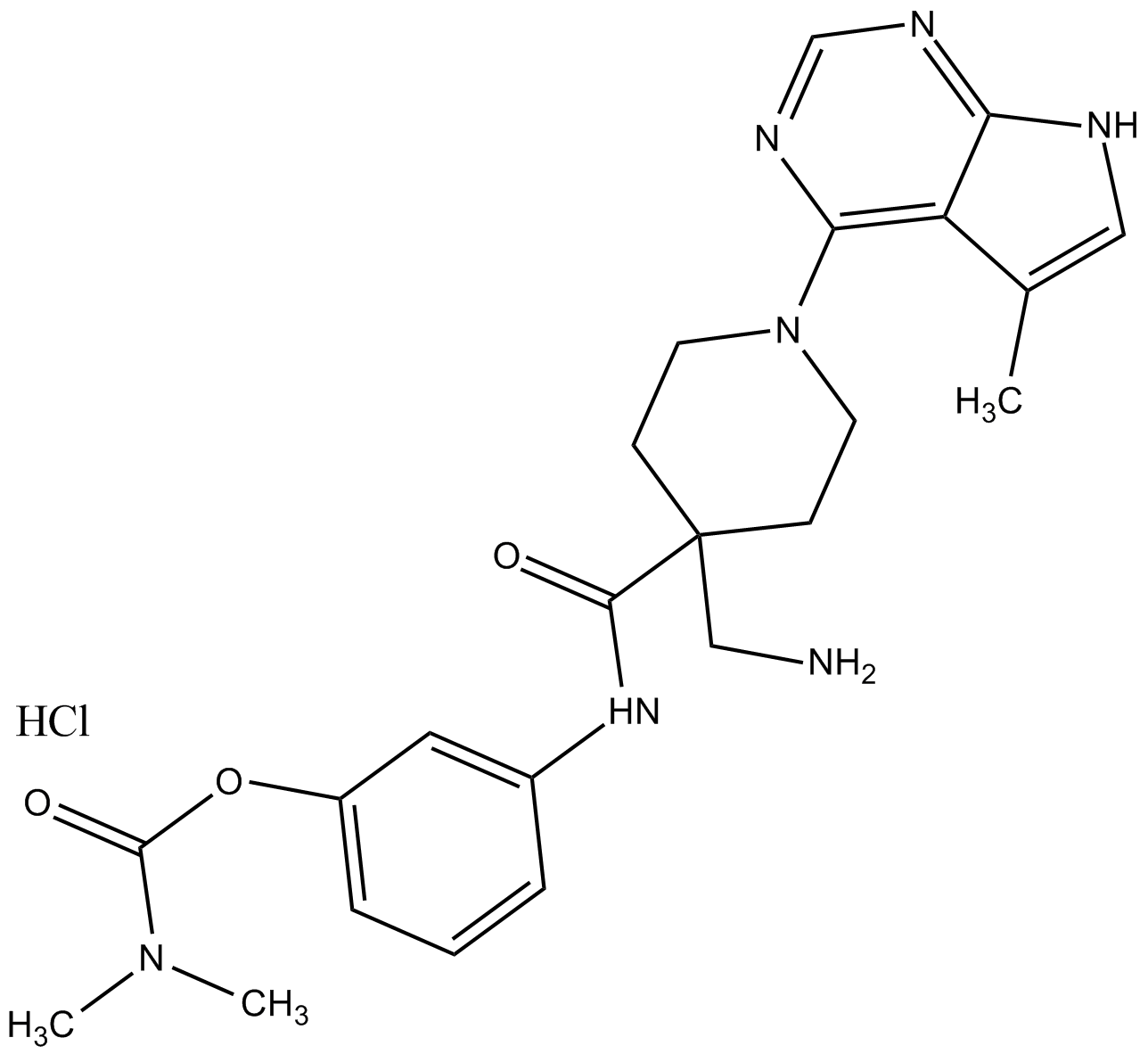LX7101 (LX-7101; LX 7101) is a novel, potent, pyrrolopyrimidine-based, and topically-usd inhibitor of LIM domain kinase 2 (LIMK2), which is a kinase associated with the regulation of intraocular pressure. It's also a ROCK inhibitor that can be applied to glaucoma patients.
Physicochemical Properties
| Molecular Formula | C23H30CLN7O3 |
| Molecular Weight | 487.99 |
| Exact Mass | 451.233 |
| Elemental Analysis | C, 61.18; H, 6.47; N, 21.71; O, 10.63 |
| CAS # | 1192189-69-7 |
| Related CAS # | 1192189-69-7;2319882-48-7 (HCl);1192189-70-0 (acetate);1374644-79-7 (besylate); |
| PubChem CID | 56962369 |
| Appearance | White to off-white solid powder |
| LogP | 3.349 |
| Hydrogen Bond Donor Count | 3 |
| Hydrogen Bond Acceptor Count | 7 |
| Rotatable Bond Count | 6 |
| Heavy Atom Count | 33 |
| Complexity | 698 |
| Defined Atom Stereocenter Count | 0 |
| SMILES | O=C(C1(C([H])([H])N([H])[H])C([H])([H])C([H])([H])N(C2C3C(C([H])([H])[H])=C([H])N([H])C=3N=C([H])N=2)C([H])([H])C1([H])[H])N([H])C1C([H])=C([H])C([H])=C(C=1[H])OC(N(C([H])([H])[H])C([H])([H])[H])=O |
| InChi Key | PWPNYABQEOGNNC-UHFFFAOYSA-N |
| InChi Code | InChI=1S/C23H29N7O3/c1-15-12-25-19-18(15)20(27-14-26-19)30-9-7-23(13-24,8-10-30)21(31)28-16-5-4-6-17(11-16)33-22(32)29(2)3/h4-6,11-12,14H,7-10,13,24H2,1-3H3,(H,28,31)(H,25,26,27) |
| Chemical Name | [3-[[4-(aminomethyl)-1-(5-methyl-7H-pyrrolo[2,3-d]pyrimidin-4-yl)piperidine-4-carbonyl]amino]phenyl] N,N-dimethylcarbamate |
| Synonyms | LX-7101; LX 7101; LX7101 |
| HS Tariff Code | 2934.99.9001 |
| Storage |
Powder-20°C 3 years 4°C 2 years In solvent -80°C 6 months -20°C 1 month |
| Shipping Condition | Room temperature (This product is stable at ambient temperature for a few days during ordinary shipping and time spent in Customs) |
Biological Activity
| Targets | ROCK2 (IC50 = 10 nM); LIMK2 (IC50 = 1.6 nM); LIMK1 (IC50 = 24 nM); PKA (IC50 = 1 nM) |
| ln Vitro | LX7101 is a dual inhibitor of ROCK and LIM-kinase used to treat glaucoma and associated ocular hypertension. Additionally, LX-7101 exhibits strong Akt1 inhibition, as evidenced by an IC50 of less than 1 nM[1]. At higher physiological ATP concentrations, LX7101's overall selectivity for LIMK2 increases. LX7101's activity under physiological conditions is mostly brought on by LIMK2 inhibition[2]. |
| ln Vivo | LX-7101 is a glaucoma treatment drug that has advanced to Phase-I clinical trials. It lowers intraocular pressure (IOP). After administration, LX-7101 significantly lowers intracranial pressure in rabbits between one and six hours[1]. The tolerability of LX-7101 topical doses on mice, rats, and rabbits' eyes is assessed. In non-GLP single dose trials, it is well tolerated at doses up to 0.5%. LX-7101 (5%) showed a long duration of action, with IOP not returning to baseline until more than 8 h postdose[2]. In the mouse IOP assay, it achieved additional reduction of IOP (5.0 mmHg total reduction) compared to the 0.1% formulation. |
| References |
[1]. Design, synthesis and biological characterization of selective LIMK inhibitors. Bioorganic & Medicinal Chemistry Letters (2015), 25(18), 4005-4010. [2]. Discovery and Development of LX7101, a Dual LIM-Kinase and ROCK Inhibitor for the Treatment of Glaucoma. ACS Medicinal Chemistry Letters (2015), 6(1), 84-88. |
| Additional Infomation | LX-7101 is under investigation in clinical trial NCT01528111 (Study to Evaluate the Safety, Tolerability, and Efficacy of LX7101 in Subjects With Primary Open-angle Glaucoma or Ocular Hypertension). |
Solubility Data
| Solubility (In Vitro) | DMSO: ~150 mg/mL (~332.2 mM) |
| Solubility (In Vivo) |
Solubility in Formulation 1: ≥ 7.5 mg/mL (16.61 mM) (saturation unknown) in 10% DMSO + 40% PEG300 + 5% Tween80 + 45% Saline (add these co-solvents sequentially from left to right, and one by one), clear solution. For example, if 1 mL of working solution is to be prepared, you can add 100 μL of 75.0 mg/mL clear DMSO stock solution to 400 μL PEG300 and mix evenly; then add 50 μL Tween-80 to the above solution and mix evenly; then add 450 μL normal saline to adjust the volume to 1 mL. Preparation of saline: Dissolve 0.9 g of sodium chloride in 100 mL ddH₂ O to obtain a clear solution. Solubility in Formulation 2: ≥ 7.5 mg/mL (16.61 mM) (saturation unknown) in 10% DMSO + 90% (20% SBE-β-CD in Saline) (add these co-solvents sequentially from left to right, and one by one), clear solution. For example, if 1 mL of working solution is to be prepared, you can add 100 μL of 75.0 mg/mL clear DMSO stock solution to 900 μL of 20% SBE-β-CD physiological saline solution and mix evenly. Preparation of 20% SBE-β-CD in Saline (4°C,1 week): Dissolve 2 g SBE-β-CD in 10 mL saline to obtain a clear solution. Solubility in Formulation 3: ≥ 7.5 mg/mL (16.61 mM) (saturation unknown) in 10% DMSO + 90% Corn Oil (add these co-solvents sequentially from left to right, and one by one), clear solution. For example, if 1 mL of working solution is to be prepared, you can add 100 μL of 75.0 mg/mL clear DMSO stock solution to 900 μL of corn oil and mix evenly. (Please use freshly prepared in vivo formulations for optimal results.) |
| Preparing Stock Solutions | 1 mg | 5 mg | 10 mg | |
| 1 mM | 2.0492 mL | 10.2461 mL | 20.4922 mL | |
| 5 mM | 0.4098 mL | 2.0492 mL | 4.0984 mL | |
| 10 mM | 0.2049 mL | 1.0246 mL | 2.0492 mL |
